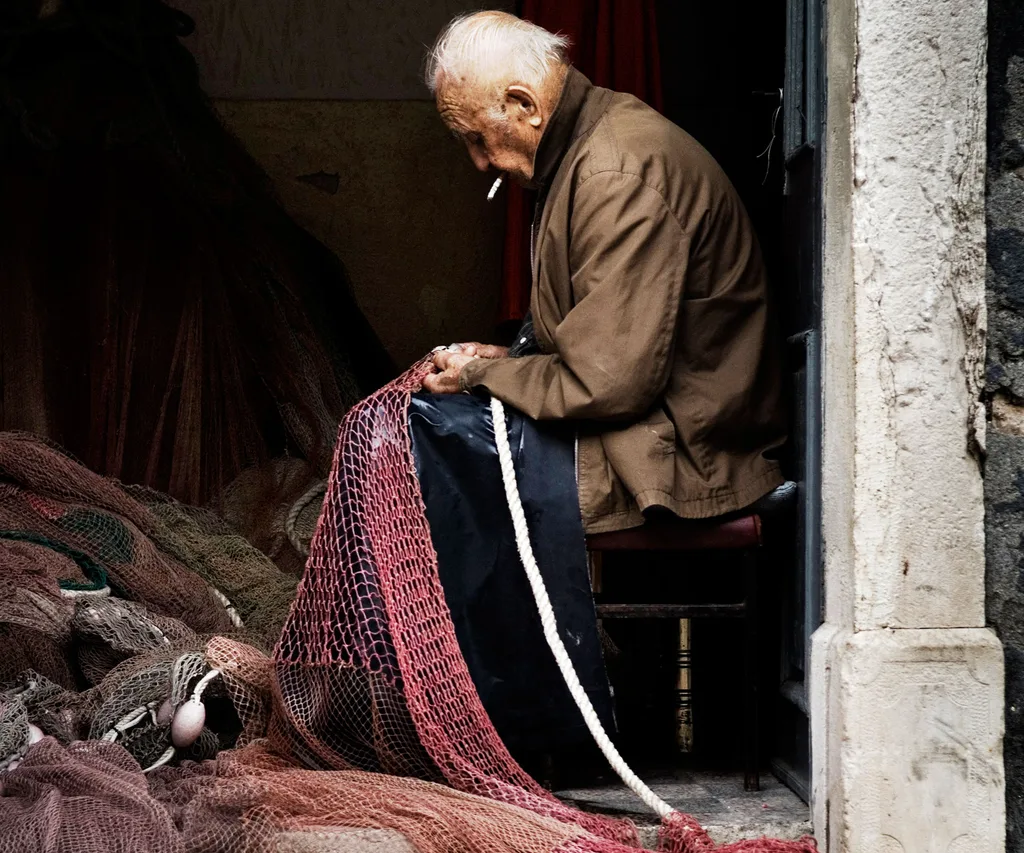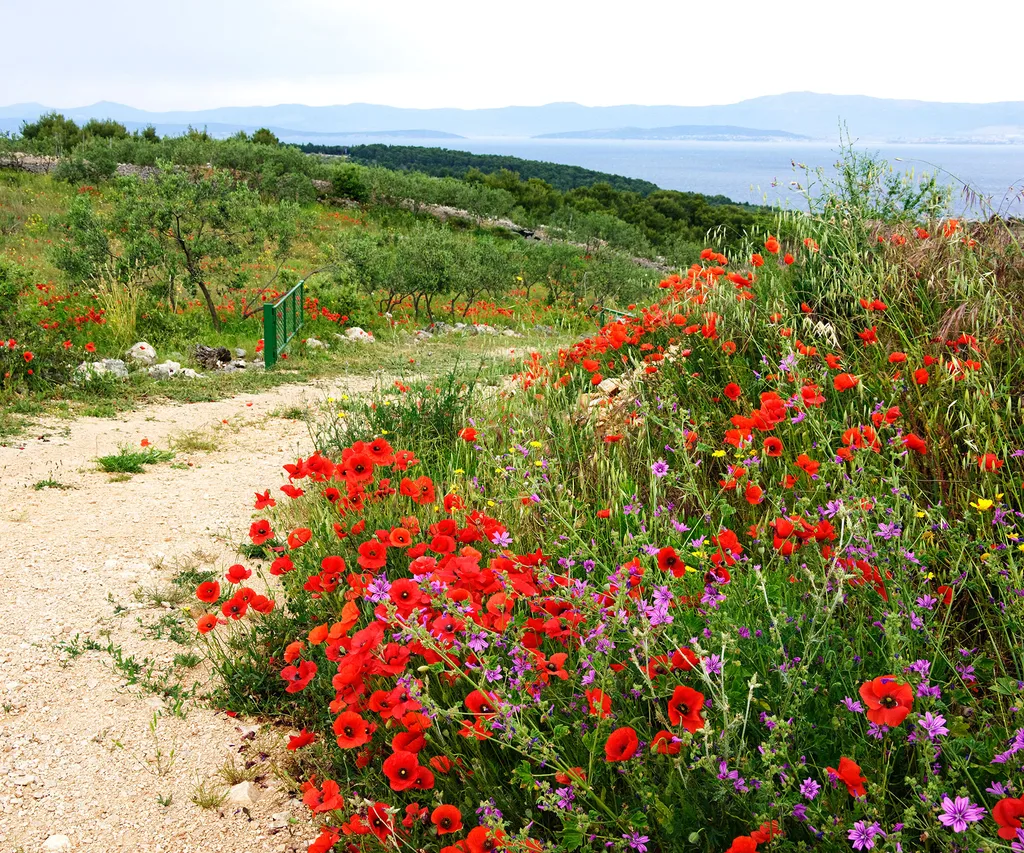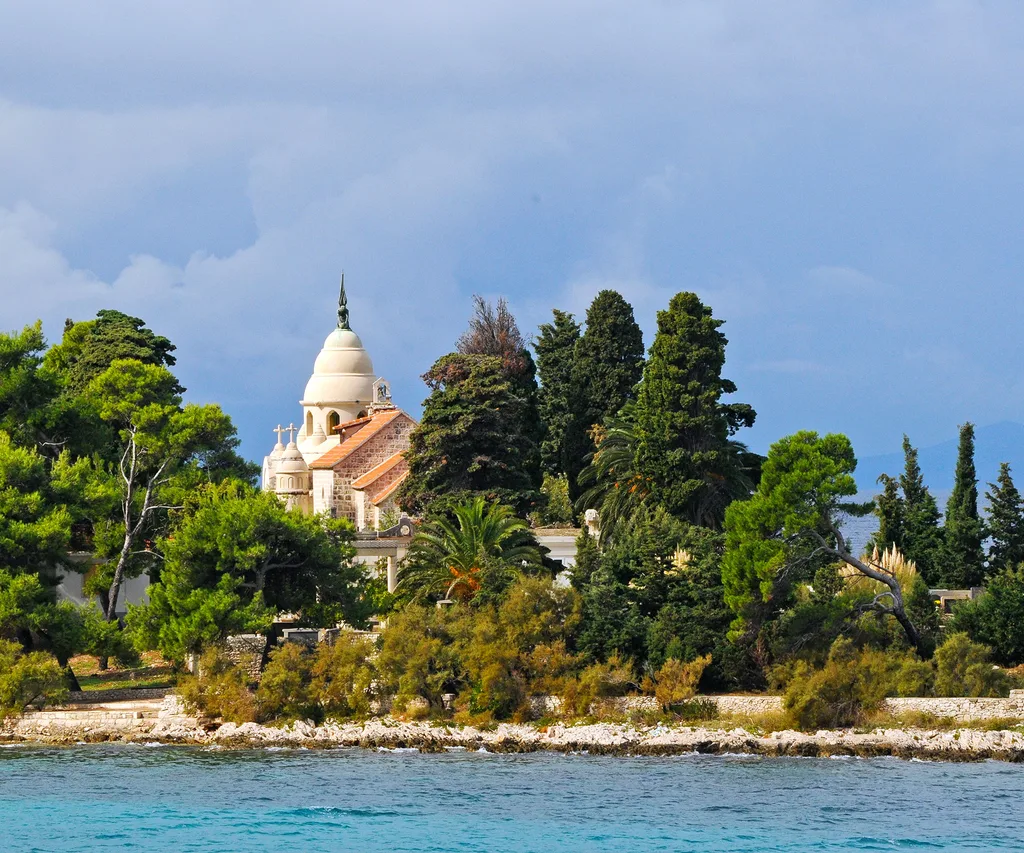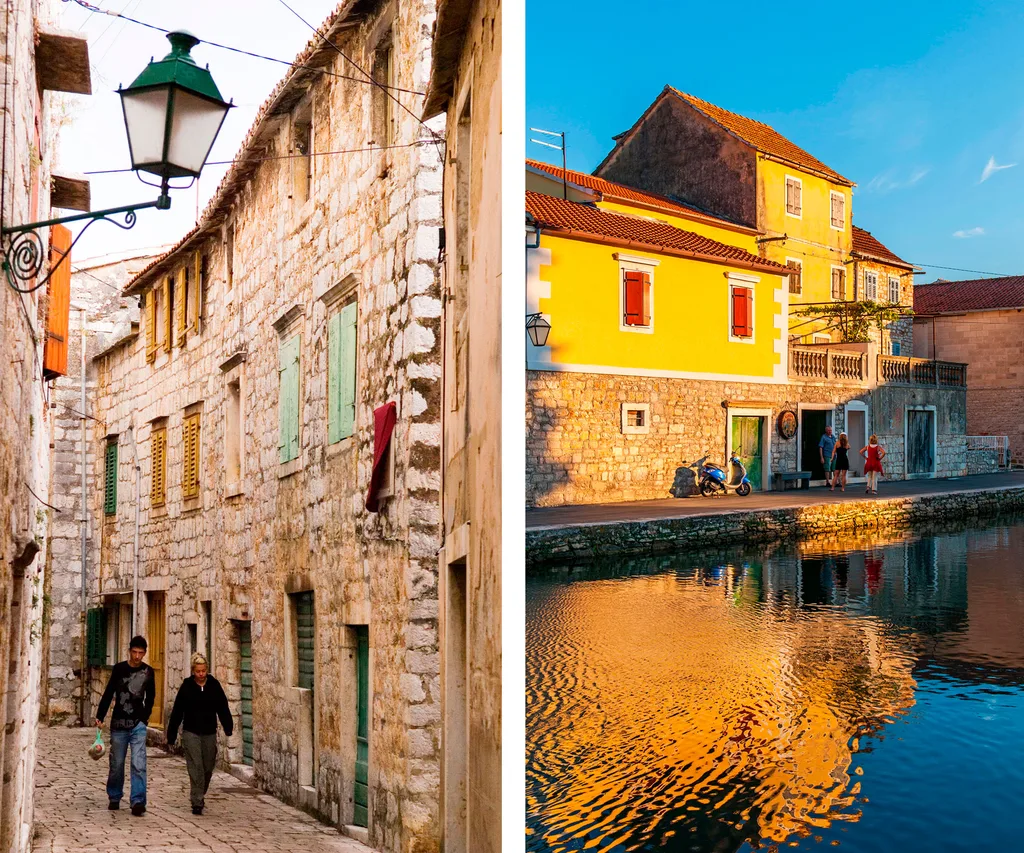The air smells fresh – of sea, pine and wild thyme. While cycling, I sometimes pass deserted homesteads where figs, grapes and pomegranates clamber over fences, begging to be picked. Ancient-tree figs are the best kind; the fruit is soft-green on the outside, merlot-coloured within and deliciously sweet.
When the roads become too steep to cycle, I push my bike. I stop and trail my hand through wild herbs and wayside flowers, occasionally notice a giant praying mantis lurking among them, and marvel at the distant sparkling blue sea and stone cottages in a keyhole bay.
Autumn is a beautiful time to cycle through Hvar and Brac, the two largest islands off the Dalmatian coast of Croatia. The dry, blistering heat has gone, as have the summer tourists, and recent rain has painted the hills shades of green.

Snapshots of Hvar: Boats at port.
The islands, stringing together in an east-west direction, run almost parallel to the rugged mountains of the Croatian coast, which we see in the distance. The mainland holds little attraction for me. The busy port city of Split, tourist-saturated Dubrovnik and the frenetic coastal highway between them are not places for bicycles or people wanting a quiet holiday.
In the summer months, these islands fill with Europeans wanting sun and sea – Harv, in particular, is a destination for jet-setters seeking anonymity; they usually arrive in superyachts, not on bicycles.
At times, cursing steep hills, it seems that travelling by boat might be a better option. But Sam, my husband, and I like to combine exercise with indulgence, and usually choose a walking holiday. This is our first cycling adventure and, foolishly, neither of us trained for it. Yes, we can both ride bikes. So what could be so challenging about riding one every day? We don’t factor in the weight of our gear in the panniers or the steepness of the hills.

Snapshots of Hvar: A fisherman repairing his net.
When bicycles are the mode of transport, the old adage that the journey is as important as the destination applies. And there are two consecutive journeys we have undertaken; that which we see as we wheel away the kilometres, and the personal, physical journey – the process of cycling.
Sometimes the uphill seems to go on forever. Click go the gears, ratcheting down, until the wheels are revolving ever so slowly while my legs pedal furiously. I give up riding and push the bike. For a few days, before I realise the time taken to get to the destination is irrelevant, I grudgingly slog uphill. Then I slow down, stop a lot and enjoy the details of what is around me.
When we get to the crest of a ridge we ratchet-up the gears and zoom down. The speed, wind, and the aqua Adriatic in the distance are an exhilarating combination, and I whoop for the joy of being on a bike.

Hvar town square is overlooked by the historic Cathedral of St Stephen.
Initially, each day’s ride ends with a sore bum and aching knees, but by the fourth day our bodies have acclimatised. Now when we arrive at our destination for the night, we are happy to leave our panniers in the accommodation and cycle further, exploring back alleys and lonely churches on nearby hills.
There are no cities on these islands, and few hotels, so it’s an unexpected treat that village accommodation is always a small apartment attached to a family home. Grapevines, ripe with fruit, hang on pergolas above doorways and often there is fresh fruit from the family orchard, and home-baked biscuits waiting for us on the table.
As we cycle the length of the islands, the five different towns we stay in cluster around sheltered harbours crammed with little fishing boats. Ambling along the harbour edge, with the boats on one side and bakeries, bars and restaurants on the other, is our late-afternoon activity. We settle into outside chairs, order wine and watch people strolling, toddlers scooting around on plastic bikes, teenagers zooming past on big bikes, children trying to catch fish, and old fishermen, with sun-gnarled skin and spiky white hair, arriving in putt-putt boats.
The late afternoons, the cold glass of wine; watching the world go by would not be so wonderful without the bonus of feeling virtuously tired after a successful day’s cycling.

Wildflowers are a common sight on the cycle route.
Both islands are, in essence, long ridges of limestone protruding from the sea with a thin covering of forest and farmland. Stone is ever-present; the buildings are all made of stone blocks, the lanes are cobbled, and even the paving around the harbours is stone.
Changes made to the houses over the years are visible in their skins; extensions have been added in different-sized block-work, and doorways have been carefully closed in with stone and mortar under the old stone lintels. On a restaurant floor different sizes of flagstone show where a wall was removed from the adjoining building to double the size of the dining room.
Churches trace their history in stone too, and in Supetar on the island of Brac blocks from a Roman arena have been used in the church’s support columns.

A chapel for mariners by the sea near Supetar on Brac Island.
I love this recycling of building material through the ages, and the deep sense of permanence these towns have.
Each town has its own version of prettiness but Hvar (which shares its name with the island) deserves special mention. It has a long history as a trading centre and port. It was settled by Greeks in 300BC, was encircled by protective stone walls in the seventh century, and has a massive hilltop fort dating from the 11th century. St Stephen’s Cathedral was built in the 15th century and most of the buildings in the old town are 600 years old. That the town is totally built of stone gives 1000 years of different architectural styles an elegant cohesiveness.
Hvar wears its heritage as casually as the old-rich wear diamonds. It’s a lived-in and working town with fishing boats in the harbour, labourers in blue overalls pausing at a café for coffee and a smoke, and shop assistants sitting on sunny steps, gossiping.

Hvar village and the Pakleni Islands.
In my late-afternoon wanderings around these picturesque little towns, I look out for places to eat away from the popular harbourside, and check menus. Some take uncompromising pride in serving island food, including the fish and squid the old fellows bring in every day, sheep’s cheese from farms in the interior, and home-preserved olives and olive oil, pressed in the traditional way. The herbs growing wild in the hills are used liberally.
The best food is that which is cheap and simple: grilled fish sprinkled with olive oil, garlic and parsley; black risotto made with squid ink; seafood stew with chunks of fish and squid served with polenta; and sheep’s cheese, onion and herbs baked in a clay pot.
The wine season is underway, with people coming over from the mainland to help with the grape harvest. The sweet smell of fermenting grapes wafts from downstairs doors and, in rustic restaurants, we ask proprietors for glasses of their best white and best red. It’s usually supplied by a neighbour and comes in hand-labelled bottles.

Hvar village and the Pakleni Islands.
We eat without worrying about calories, knowing they will be burned off biking, amble back to the little apartment and sleep deep and dreamlessly. In the morning we pack the panniers, pull on padded cycle pants and hit the road. We stop often; to look at the donkey who is looking at us, to snack on wild figs and grapes, to admire a sturdy little lighthouse on a rocky island, and to notice the wildflowers growing in an enthusiastic post-summer burst of fecundity.
Sometimes a black cloud appears and big blobs of rain splatter on the asphalt. It’s sweet, the smell of rain on hot road. There is no shelter, so we cycle on and are soon soaked. Raindrops run down my face and over my lips. The taste is of salt from sweat and sunscreen.
On the last day, we comfortably cycle 40 hilly kilometres to catch the ferry from the east end of Hvar to the mainland. Our bodies are conditioned and the knee-killing and bum-numbing agony of the first few days has gone.
We relish the many-layered pleasures of the journey; the physicality of cycling, the intimacy with the landscape, the ancient villages in which we stay, and the well-earned delight of the evenings’ hearty Dalmatian dinners.
Would I do it again? Yes. We want more, and wish we had signed up for the longer cycling adventure that included the neighbouring island of Korcula. That gives us a good reason to return.

People walking through a cobbled street and Vrboska village, Hvar.
Five places not to be missed
Vrboska and Jelsa are two ancient, sleepy villages on Hvar island. Cycle or walk the 5km waterside road between them and enjoy the dramatic landscape of rocky hills, pine forests and inky waters. Both towns have pretty harbours with waterside cafés to chill-out in.
The Cathedral of St Stephen forms a stunning backdrop to the town square in Hvar. The bell tower rises four levels, each more elaborate than the last. It has old, hallowed walls of cream marble, Renaissance religious paintings and an ornately carved wooden main altar. It has a beauty, spirituality and feeling of antiquity that is impossible to find in New Zealand.
The Pakleni Islands, a chain of 21 little wooded isles near Hvar, have crystal-clear water, hidden beaches and deserted lagoons. Hire a dinghy with a baby outboard from Hvar harbour and spend the day exploring, or enlist one of the retired fishermen with beautiful old wooden boats to take you on a tiki tour.
Antika, House of Food, a backstreet restaurant in Stari Grad (where the ferry to Hvar island arrives), has an ancient vibe, quirky decor with rustic antiques, and above all, simple, natural, local food. The herbs, olives and olive oil are from the owner’s farm, the wine from the neighbour’s vineyard, the sheep’s cheese from a cousin, and the fish is fresh from the morning’s catch.
At sunset, stroll around Supetar harbour, on Brac island. The fishermen come home in their bright wooden boats, the low sun lights up the old stone town and, just beyond the harbour, there is a pretty chapel sitting on a wooded promontory almost surrounded by sea.
Fact file
Cycling: UTracks arranges self-guided cycle and guided cycle and boat adventures through the Dalmatian Islands of Croatia. The programme includes accommodation, excellent bikes, panniers, helmets and detailed maps and instructions. utracks.co.nz
How to get there: Singapore Airlines has daily departures from Auckland to Munich, travelling via Singapore. There are daily flights between Munich and Dubrovnik on Croatia Airlines.
When to go: Spring or autumn.


